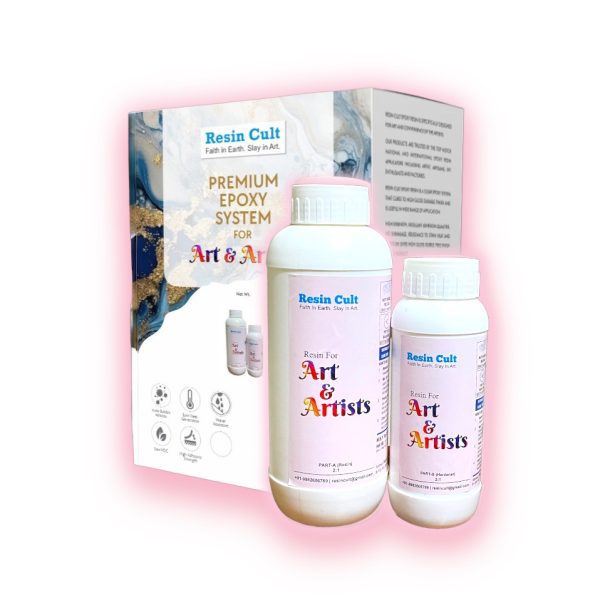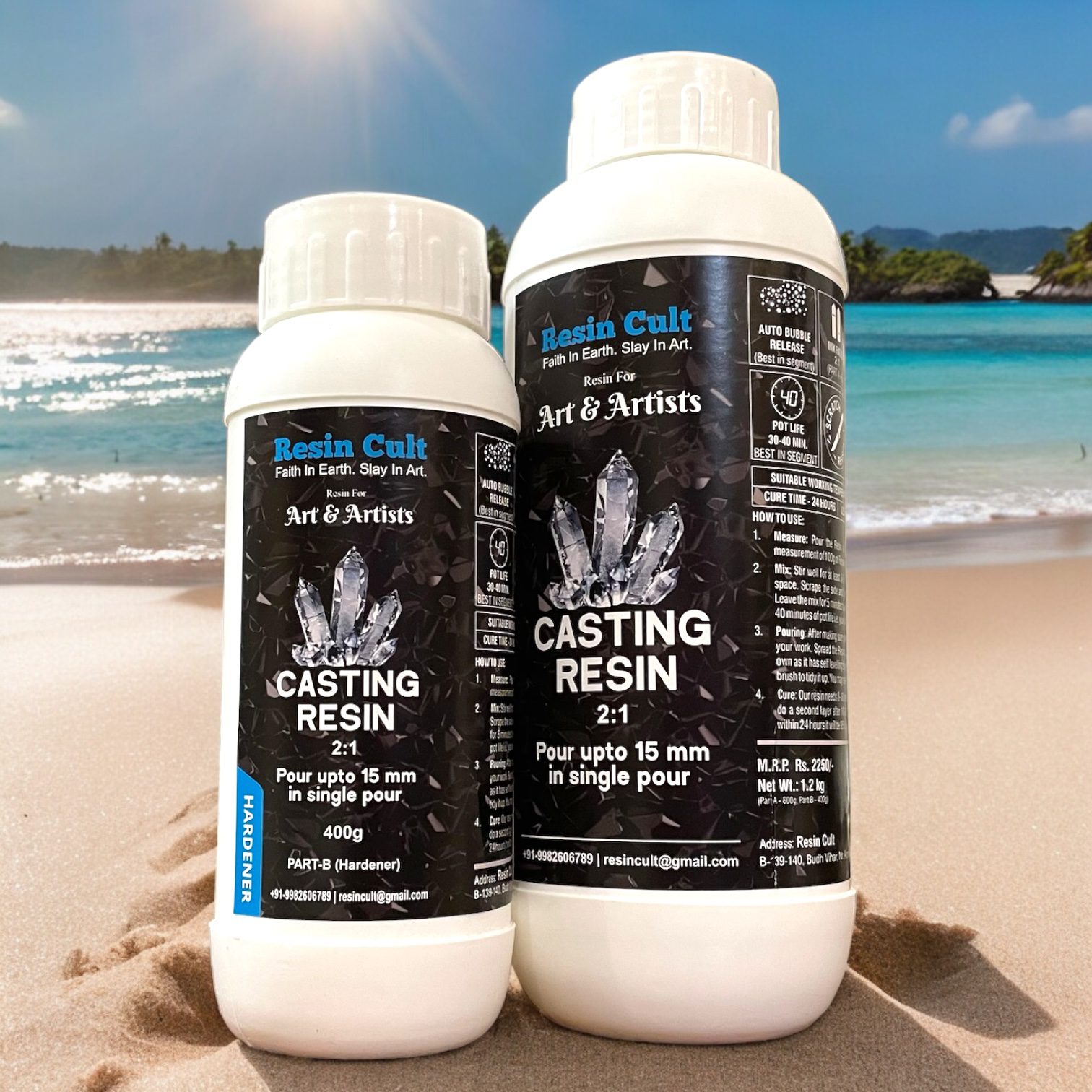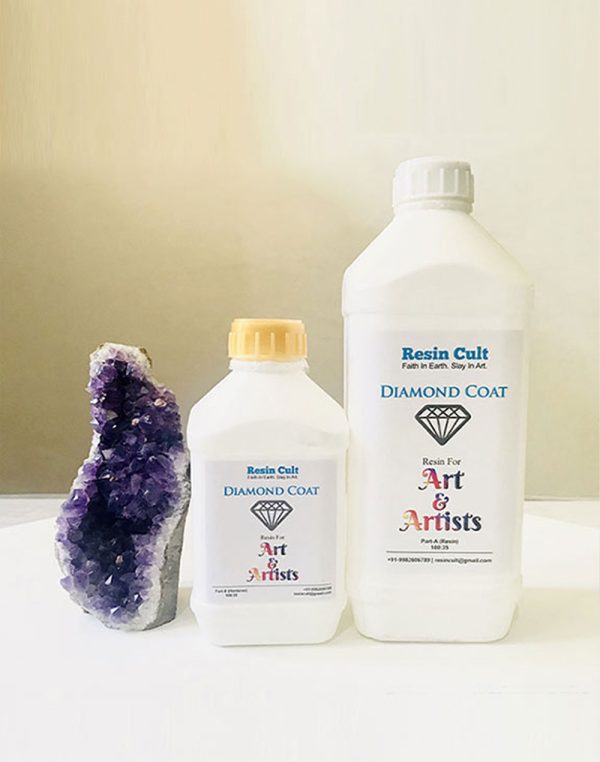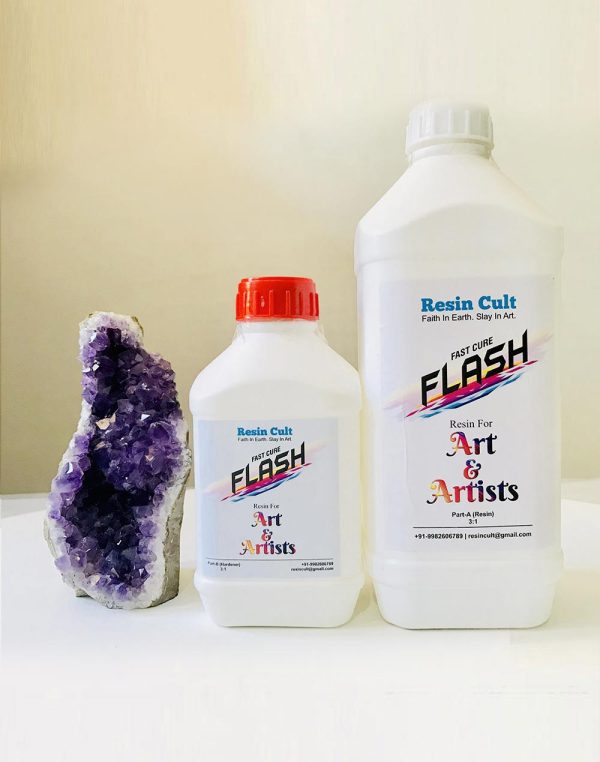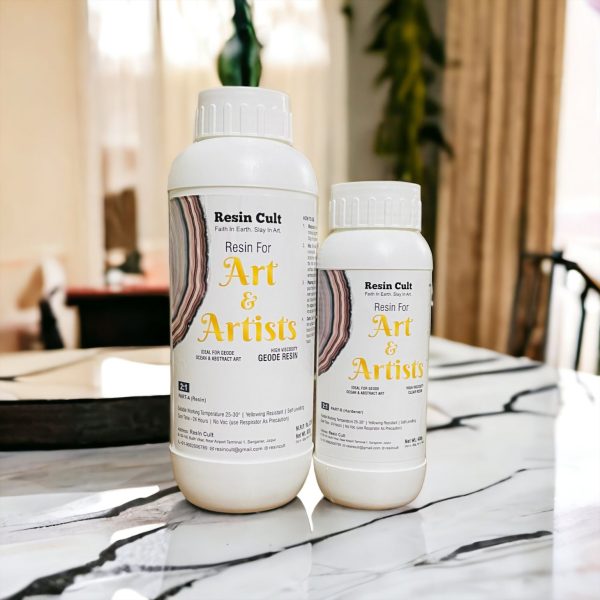Best Resin to Use During Monsoon in India
The monsoon season brings a fresh wave of inspiration for resin artists across India—but also a unique set of challenges. High humidity, unpredictable temperatures, and moisture-laden air can wreak havoc on your resin projects, causing slow curing, tacky finishes, yellowing, and cloudiness.
Whether you’re working on resin art, tabletops, jewelry, or home décor, it’s essential to choose a resin that performs reliably during the rainy season.
That’s where ResinCult comes in.
Specially formulated for Indian weather conditions, ResinCult offers the best resin in India—engineered to resist humidity, maintain a crystal-clear finish, and cure efficiently even in high-moisture environments. Whether you’re a beginner or a seasoned artist, our resins deliver consistent, professional results in any season.
If you’ve been searching for epoxy resin in India that’s truly monsoon-proof, ResinCult is your trusted companion.
Explore Our Monsoon Collection for Your Next Masterpiece
Why Resin Behaves Differently During Monsoon
India’s monsoon season brings high humidity, fluctuating temperatures, and moisture-rich air — all of which significantly impact the epoxy resin curing process.
🔬 The Science Behind Resin & Humidity
Epoxy resin cures through an exothermic chemical reaction between resin and hardener. For optimal results, this reaction requires a stable environment with controlled temperature and low humidity. During monsoon, moisture particles in the air can interfere with this process, leading to unexpected outcomes.
🌧️ Common Resin Problems During Monsoon in India:
- Prolonged Curing Time: High humidity slows down the chemical reaction, causing resin to stay soft or rubbery longer than usual. This can delay demolding and increase chances of dust and moisture contamination.
- Cloudy or Milky Finish: Moisture can get trapped inside the resin, especially when poured too thick or in damp environments. This results in a foggy or hazy appearance instead of the desired crystal-clear finish.
- Surface Sweating: Due to rapid temperature changes, resin surfaces may “sweat” or appear oily. This sticky residue is a mix of uncured resin and moisture reacting with air.
- Sticky or Tacky Layers: Inconsistent curing often leaves the top layer sticky, especially in thin coats. This tackiness prevents sanding, layering, or finishing properly.
🧪 Why Moisture Sensitivity Matters
Moisture reacts with certain hardener compounds, forming unwanted by-products like amines that prevent full curing. That’s why it’s crucial to use resins specifically designed for humid climates — like ResinCult, which is formulated to cure effectively in Indian monsoon conditions.
Pro Tip: Always choose a monsoon-compatible epoxy resin India artists trust — one that’s tested for heat resistance, anti-yellowing, and fast curing even in high-humidity zones.
What to Look for in a Monsoon-Safe Resin
Not all epoxy resins are created equal—especially when it comes to working in India’s monsoon season. The right resin can make or break your project when dealing with high humidity, moisture-laden air, and unpredictable temperatures. To ensure flawless results, here’s what you should look for in a monsoon-safe epoxy resin in India:
- Long Working Time: Monsoon often means a slower cure, but that doesn’t mean you should rush your work. Look for resin with a 90-minute working time (like ResinCult’s Artist Resin 3:1 or Diamond Resin 3:1), giving you flexibility to pour, place, and level without stress—even if the air is sticky.
- High Resistance to Ambient Humidity: Humidity is the top resin killer during monsoon. Choose a formula specifically engineered to resist moisture absorption during curing. This prevents tackiness, bubble formation, and surface sweating—common issues in traditional resins.
- Fast Layer Time: In wet weather, fast-setting properties are essential. A quick layer time (like 5–12 hours) helps seal the surface quickly and reduces exposure to atmospheric moisture, especially if you’re working in layers.
- No Yellowing or Blooming: Monsoon conditions often lead to yellowing, fogginess, or “blooming” (white haze on the surface). A UV-resistant and non-reactive resin ensures a crystal-clear finish, even in high humidity zones.
- Strong Bonding in Fluctuating Temperatures: Monsoon brings rapid shifts in indoor and outdoor temperatures. Your resin should maintain strong adhesion and thermal stability, preventing cracks, peeling, or uncured patches.
- UV Resistance: Even during rainy seasons, UV rays from diffused sunlight can affect your resin art and tabletops. UV-resistant formulas prevent premature yellowing and degradation over time.
✅ ResinCult resins are designed for Indian conditions, offering long workability, rapid layer set time, and crystal-clear, durable finishes making them the best resin in India for all-weather projects.
Best Resin Types from ResinCult for Monsoon
During the monsoon, choosing the right type of resin is crucial to avoid curing failures, surface sweating, or foggy finishes. At ResinCult, we’ve crafted specialized formulations to meet the challenges of India’s humid climate. Here’s a breakdown of the best art resin types for monsoon use, based on their technical performance and weather tolerance:
🧪 Artist Resin 3:1
🛠️ Best Use: Coasters, platters, floral preservation
✅ Why It Works: With a generous 90-minute working time and excellent self-leveling properties, this resin gives you ample time to work—even in slow-drying conditions. Ideal for delicate placement of flowers or designs, it cures crystal-clear, resisting yellowing and moisture interference.
💡 Perfect for monsoon resin art where precision matters most.
🎨 Artist Resin 2:1
🛠️ Best Use: Top coats, marble effects, geodes, floral preservation, platters, and coasters
✅ Why It Works: With a working time of 45 minutes and a controlled layer time of 6–8 hours, Artist Resin 2:1 offers the perfect balance between clarity and detail. Its thin layering capacity (5 mm) ensures reduced risk of surface sweating or cloudiness—making it ideal for humid conditions and precision work. Engineered with anti-yellowing technology and smooth self-leveling, it delivers a glass-like finish every time.
🌧️ Monsoon-Ready Precision with ResinCult’s Artist Resin 2:1
💎 Geode Resin 2:1
🛠️ Best Use: Fine detailing, jewelry, marble finishes, top coats
✅ Why It Works: With a thin 3mm layer pour limit, this resin minimizes tacky layers and cures smoothly even in high humidity. Ideal for top coatings, where surface perfection is critical, and for jewelry that demands high-gloss, bubble-free results.
✨ Humidity-resistant and perfect for monsoon layering work.
🪵 Diamond Resin 3:1
🛠️ Best Use: Deep castings, river tables, furniture pieces
✅ Why It Works: This deep pour resin supports up to 20 mm single layer thickness, making it ideal for large projects during monsoon. The long 90-minute working time and advanced formula allow even curing without surface sweating or bloom, even in unstable temperatures.
🌧️ Consistent, deep clarity even in monsoon conditions.
Tips for Using Resin in Humid Conditions
Stay ahead of monsoon challenges with these expert-backed tips to ensure your resin cures crystal clear and smooth even in high humidity:
- Use a dehumidifier or AC: Maintain indoor humidity below 50% to avoid sticky layers and curing delays.
- Seal your molds properly: Use a mold sealant or varnish—especially on wood or silicone molds—to block moisture from interfering with the resin.
- Avoid water-based pigments: Stick to oil-based or powder pigments only. Water-based colors can cause bubbles, cloudiness, or soft curing.
- Pour during warmest hours: Resin reacts best between 11 AM and 4 PM, when humidity is lowest and temperature is ideal.
- Wait a full 72 hours before touching: Even if it looks dry, resin needs complete internal cure time to harden in monsoon weather.
Pro Tip: Always choose ResinCult resins—formulated to cure reliably in India’s monsoon conditions. This ensures a professional finish, every time.
Common Resin Mistakes During Monsoon (And How to Avoid Them)
Working with resin during the rainy season can be frustrating if you’re not careful. Humid weather affects everything from curing speed to clarity. Here are the most common resin mistakes artists make during monsoon—plus how to avoid them with ease.
⚠️ Mistake #1: Mixing Resin Too Fast:
- Problem: Traps excess air, causing visible bubbles.
- Solution: Mix slowly and consistently for at least 3–5 minutes to avoid foaming.
⚠️ Mistake #2: Pouring Too Thick in One Go
- Problem: Moisture gets trapped in deep layers, leading to tacky or uncured centers.
- Solution: Pour in thinner layers and allow each one to cure before adding the next.
⚠️ Mistake #3: Using Expired Resin
- Problem: Old resin reacts poorly to humidity, leading to poor bonding or hazy results.
- Solution: Always check the manufacture and expiry date—ResinCult resins come with a 6-month shelf life for best performance.
⚠️ Mistake #4: Rushing the Demolding Process
- Problem: Touching or demolding before 72 hours can cause fingerprints, impressions, or surface distortion.
- Solution: Be patient—especially in monsoon. Wait the full 72-hour cure time before handling.
Monsoon Resin Troubleshooting Chart
| Problem | Likely Cause | Quick Fix |
|---|---|---|
| Bubbles won’t pop | Fast mixing / high humidity | Mix slowly, use torch or heat gun briefly |
| Cloudy surface | Moisture in air or mold | Use sealed molds & dehumidify workspace |
| Sticky/tacky finish | Poured too thick or early | Pour thinner layers, increase airflow |
| Yellow tint | UV exposure or poor resin | Use UV-resistant resin like ResinCult |
| Soft center | Incomplete internal cure | Allow full 72-hour cure in stable temperature |
FAQs
Does resin work during monsoon in India?
Yes, resin absolutely works during monsoon in India—but with precautions. High humidity affects curing speed and clarity, which is why it’s important to use a resin that’s formulated for moisture-heavy climates.
ResinCult resins are engineered to resist monsoon-related issues like surface sweating, cloudiness, and incomplete curing, ensuring reliable results even when the weather isn’t ideal.
Which resin cures best in humidity?
The best resins for humid weather are those with:
– Balanced working and curing times
– Anti-yellowing additives
– Strong bonding under moisture
From ResinCult, we recommend:
✅ Artist Resin 2:1 – Provides precise detailing and smooth top coats with controlled curing in humid conditions
✅ Geode Resin 2:1 – Thin layering helps resist surface tackiness
✅ Diamond Resin 3:1 – Ideal for deep castings and maintains structure in damp air
These formulas are trusted by artists and makers across India for consistent monsoon performance.
How do I prevent tacky resin during rainy season?
Tacky resin is usually caused by excess humidity or premature handling. Here’s how to prevent it:
✔ Use a dehumidifier or AC while working
✔ Choose a resin with high moisture resistance like ResinCult
✔ Avoid water-based pigments or additives
✔ Let each layer cure completely—typically 72 hours in monsoon
✔ Pour during midday, when humidity is lower
Following these steps helps ensure a crystal-clear, fully cured finish, even in the rainy season.

